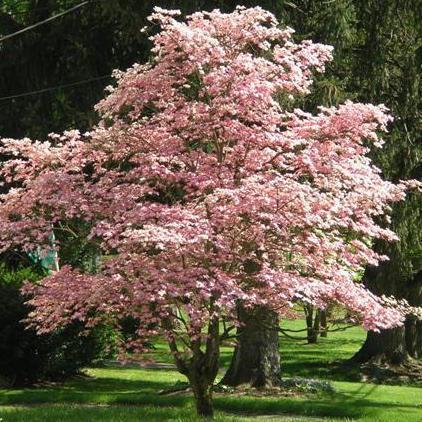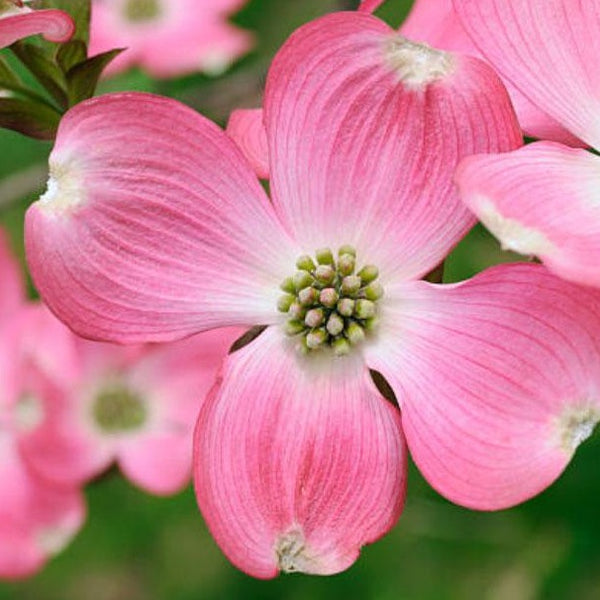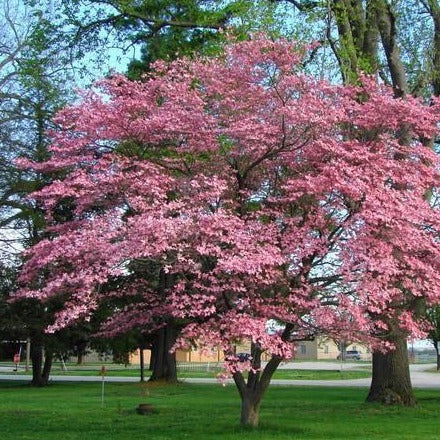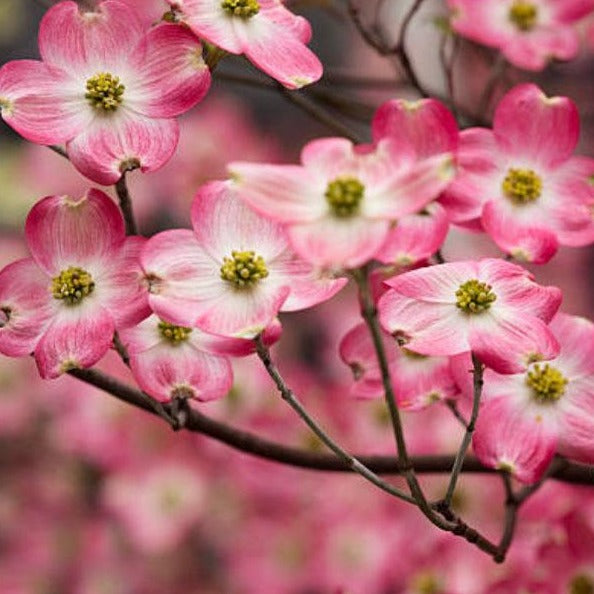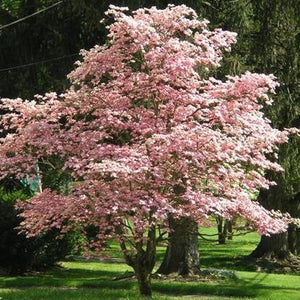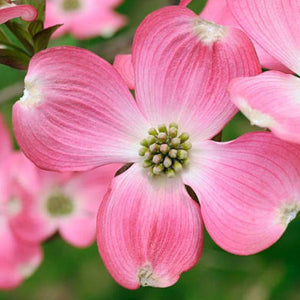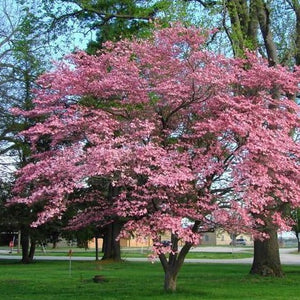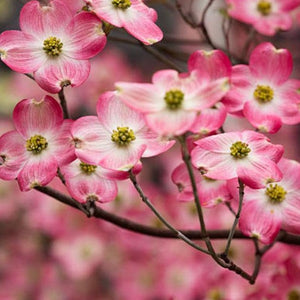Pink Dogwood Tree
Product Details
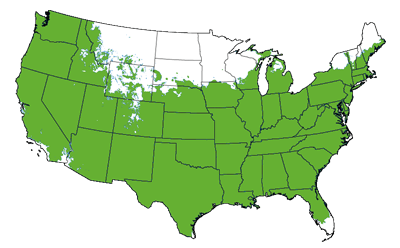 Growing Zones 5-9
Growing Zones 5-9
| Soil Type | Acidic, Adaptable, Well Drained |
| Sunlight | Full, Partial |
| Drought Tolerance | Good |
| Mature Height | 20-30 Feet |
| Mature Width | 20-30 Feet |
| Fall Color | Red |
| Bloom Color | Pink |
| Shipping Restriction | AZ, FL |
When the Pink Dogwood blossoms you know that spring has sprung! This popular, native tree is a vision of beauty not only in the spring but throughout the year!
Stunning pink blossoms announce the arrival of spring. These beloved 4 petaled flowers coat your tree with a layer of pretty pink in late winter and early spring. Soon green, oval foliage will fill out your tree and add a rich, fullness to your landscape.
In fall the leaves turn a deep red and your Pink Dogwood begins to produce shiny, red fruit that lasts throughout winter. These fruits are an important source of food for birds and other wildlife. The attractive, textured gray to brown bark, red berries, and the beautiful shape of this tree keep it interesting even throughout winter!
At only 15-25 feet tall and wide at maturity, the Pink Dogwood is a good fit for many locations in your yard. You will love looking out your window and seeing your dogwood blossoms flutter in the breeze.
The Pink Flowering Dogwood's blooms are the perfect treat after a cold, dreary winter. Your spirits will immediately lift at this first sign of spring. These flowers are a sure indicator that warmth and sunshine are headed your way!
Give the gift of spring to a loved one or yourself! We all deserve a little beauty and the Pink Dogwood offers this in spades for years to come.
Where To Plant A Pink Dogwood
Plant this adaptable Dogwood in a spot with well drained, slighlty acidic soil and full sun to part shade exposure. Space atleast 25 feet apart in grow zones 5-9 to accomodate a 20-30 foot spread at maturity.
When Does This Tree Bloom?
Stunning pink blossoms announce the arrival of spring. These beloved 4 petaled flowers coat your tree with a layer of pretty pink in late winter and early spring.
What Are Good Companion Plants For This Dogwood?
Try adding a White or Red Dogwood or two in with your Pink Dogwoods for a pretty, but subtle difference. Azaleas are also known to be great companion plants for these trees as they also love to show off their blooms and contribute to the showy colors in the fall season.
When planting your Dogwood be sure you have the right location and conditions for your new tree to thrive. Spring and fall are ideal times to plant. However, if you avoid extreme temperatures you can plant almost any time of the year.
These trees tolerate full sun to part shade. Provide some shade if you live in a warmer zone. Dogwoods prefer soil that is well-drained, neutral to acidic, and nutrient rich, but they are adaptable to many soils. If you have alkaline soil, you can amend your soil. To acidify your soil, amend with compost, elemental sulfur, or use fertilizers specific for acid loving plants. Mulching with pine straw or pine bark will help over time as they begin to break down, but are not an immediate solution for increasing acidity. Mulching will also aid in keeping the shallow roots cool and moist. Add a layer of 2 to 3 inches of mulch. Do not allow the mulch to touch the trunk as this increases the chances of pests and disease. Water deeply 1 to 2 times per week when newly planted. Once established this variety is drought tolerant, but will grow and bloom best when the soil is watered when it is dry. Fertilize in early spring and when planting to give your tree a boost. Choose a balanced, slow release fertilizer like the one we carry here. Dogwoods do not generally require pruning, but if needed prune when they are dormant to remove any dead, dying, or crowded branches. Dogwoods are deer tolerant and can be considered the perfect flowering tree for zone 5, zone 6, zone 7, zone 8, or zone 9.
The best way to prevent disease and pests is by providing the appropriate care for your plants. Proper location choice, watering and fertilization are the keys to your success. Avoid problems with Dogwood Borer insects by ensuring your tree remains free from damage, especially from lawn equipment. Mulching helps to keep weeds at bay which eliminates the need to use lawn equipment near your tree Borers look for a hole or weak spot to penetrate. Scale is an immobile insect that can affect Dogwoods. You can treat this pest with horticultural oil. Be sure to coat the entire tree. Powdery Mildew can be a problem in Dogwoods. When this disease occurs in late summer it isn't likely to cause any problems for your tree. Simply remove and discard the affected leaves when your tree sheds them. When Powdery Mildew occurs earlier in Spring, you can treat with a copper fungicide to control the spread of this disease. Spot Anthracnose is a common fungus of Dogwoods. This is often seen in extremely wet seasons. This disease is cosmetic and will not affect the overall health of your tree. If you have a problem with any fungal issues year after year, treat with a copper fungicide in early spring to prevent infection. Dogwood's branches that are crowded likely lack air flow and can greatly increase your risk of fungal issues. Thin out the branches when your tree is dormant to increase air flow.
At only 15-25 feet tall and wide at maturity the Pink Dogwood is a good fit for many locations in your yard. If you have any natural areas around your property, plant your pink dogwood off to the side to make it really stand out. Hostas are a perfect complement to your dogwood tree because these shade loving perennials perform well planted in large clusters underneath. Try adding a White or Red Dogwood or two in with your Pink Dogwoods for a pretty, but subtle difference. You will love looking out your window and seeing your dogwood blossoms flutter in the breeze. Looking for more more color? Add in azaleas, burning bushes, forsythia, abelia etc. You will have a brilliant display throughout the year. The Pink Dogwood even makes a perfect specimen tree at night; simply add an uplight to show your tree off after dark.
For additional options, be sure to browse our Dogwood and Flowering Tree collections.



